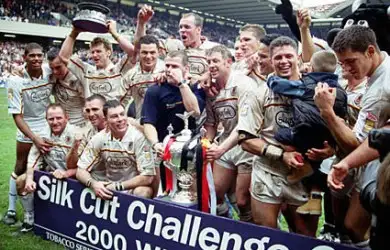The Super League Revolution – Part 3

The new millennium brought with it renewed hope for the RFL of spreading the rugby league gospel. Paris St. Germain and Gateshead Thunder were fast being forgotten (although the latter would re-launch as a Northern Ford Premiership club in 2001), and the sport’s governing body was again eager to break new ground wherever it could.
Positive news on the expansion front was being written every day in the fledgling summer conference. Many of the teams relied heavily on union players turning out during their first XV’s close season but, for the first time in the sport’s history, the greatest game was being played in such exotic destinations as Devon, Ipswich, Coventry and St. Ives. The conference had founded as a 10-team competition in 1997 but had gone from strength to strength over the seasons that followed and continues to grow to this day.
Back in the heartlands, the Sheffield Eagles, who had hoped to capitalise on their recent cup success, ‘merged’ with Huddersfield to form the ‘Huddersfield-Sheffield Giants’. Unsurprisingly, with a vast majority of home games taking place in Huddersfield, the Eagles fans did not embrace the new franchise. By 2001, ‘Sheffield’ had been dropped from the name and the Eagles re-launched thanks to the efforts of disenchanted supporters in 2002.
The eve of the century also saw one of the sport’s most famous names drop out of the professional ranks. Bramley, who, by the end of their existence were sharing Headingley with their more illustrious neighbours and fielding sides made of local amateurs and half-fit Leeds players, dropped out of the Northern Ford Premiership in 1999. Those resourceful, determined, passionate people who follow our game though were, once again, ready to strike back. Three short years later, Bramley, now carrying the ‘Buffaloes’ monicker, were back in action and have been knocking on the door of the semi-pro hierarchy ever since.
It was an unpredictable time for lower league clubs with many clearly struggling to keep up with the pace of change in the sport. Super League clubs, on the other hand, were growing in stature on and off the pitch, thanks in no small part to the money generated by Sky television’s extensive coverage of the elite division.
It was because of this coverage that many clubs abandoned the traditional 3.00pm Sunday slot, seen by many, as part of rugby league’s heritage. Since Super League’s inception, Friday and Saturday evening matches are becoming more and more commonplace with Sky keen to provide their subscribers with live sporting action in the evenings to compliment the weekend’s soccer.
On the field meanwhile, the big four of St. Helens, Wigan, Bradford and Leeds competed for the sport’s silverware. St. Helens’ Super League title win in 2000 was made even sweeter by the fact they beat bitter rivals Wigan in the Grand Final to claim it. The Challenge Cup, on the road at Murrayfield in Edinburgh, was contested by the sport’s other big-time rivalry – the Bulls eventually edging out the Rhinos in front of 67,000 people.
2001 saw the Warriors fall at the final hurdle for the second consecutive year, beaten emphatically, this time by Bradford, with Aussie-cum-Irish international Michael Withers blazing over for a hat-trick. The Bulls were not able to complete the double however with St. Helens lifting the famous old cup in the first ever Challenge Cup final to be held on enemy soil at Twickenham.
New Wembley was still like 6 years away but the RFL ceased the opportunity to take the final on the road and showcase the sport to new audiences. Following the success of the Murrayfield and Twickenham finals, the Challenge Cup was taken to Wales and the recently completed Millennium Stadium. The final remained in Cardiff for 3 years before a one-year stop back at Twickenham in 2006. The closure of old Wembley had presented a challenge to the sport’s oldest competition, one that it passed with flying colours.